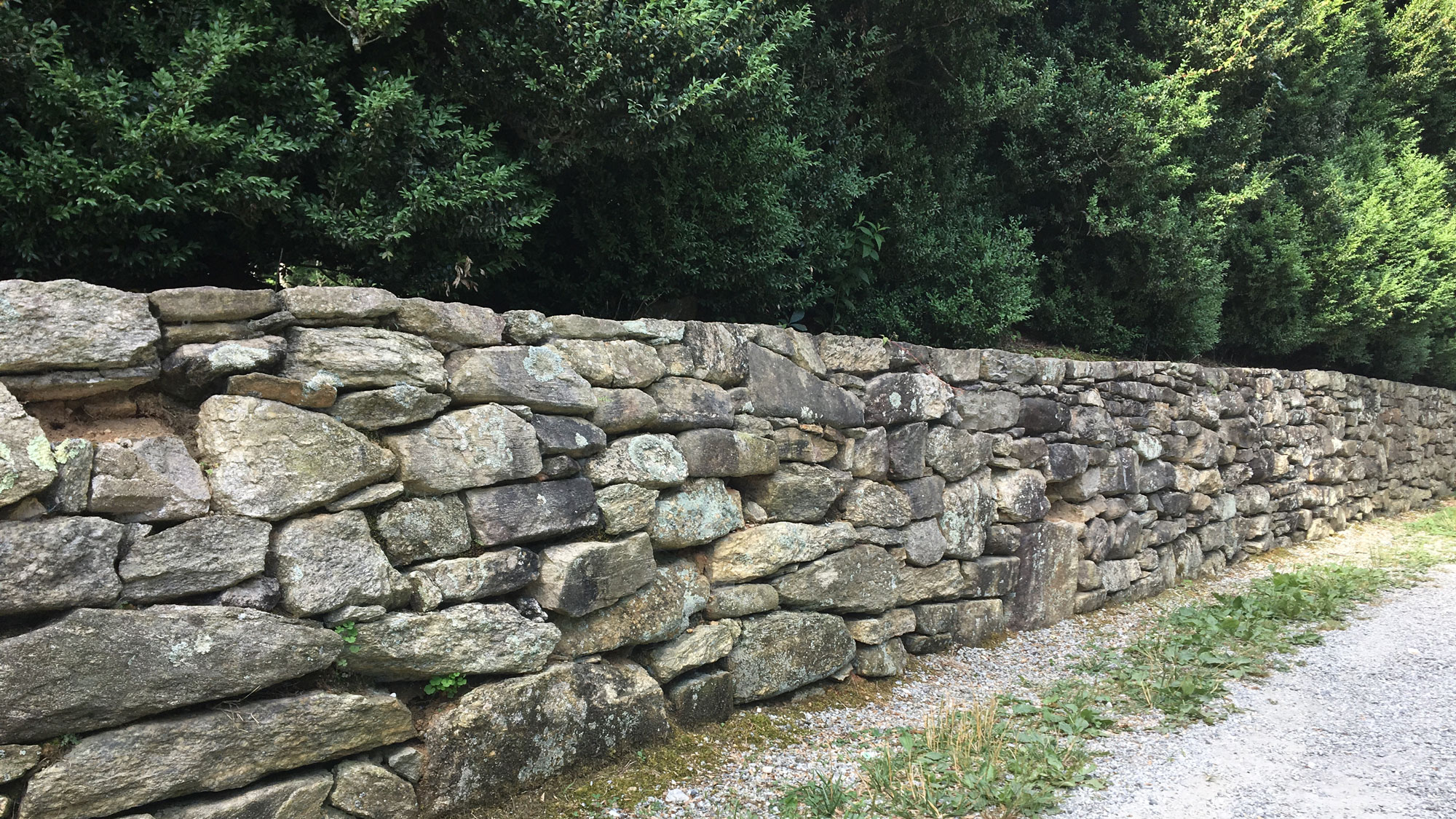Before Sandburg, There Was Smyth
/In the mid-1830s, C.G. Memminger of Charleston and a member of Jefferson Davis’ Confederate Cabinet, ventured to Flat Rock in search of a summer home. Unable to find something that he liked, he purchased land and hired architect, Charles F. Reichardt, to build a large dwelling he named Rock Hill. Today the house is known as Connemara, or simply The Carl Sandburg Home.
View of Connemara in late winter or early spring 1901. Image shows East Porch, the bay window on the west side of the house, and the new front steps, all apparently added by the Greggs around 1890.
In 1889, Memminger’s son sold Rock Hill to Mary and William Gregg, Jr. for $10,000. William Gregg, Sr. has been described by at least one historian as “the most significant figure in the development of cotton mills in the South.” Gregg, Jr. was listed in the 1880 census to have been a “planter” but presumably inherited his wealth from his father who died in 1867.
From the Historic Structure Report, Connemara Main House, published in 2005:
Gregg’s widow retained ownership of Rock Hill for nearly six years after his death, and it is not known what finally precipitated the decision to sell. It is possible that too much of the family’s income depended on South Carolina’s phosphate industry, which was well on the way to collapse in the face of competition from the new mines in Florida. Or it is possible that the decision to sell related to the tragic drowning of a child, perhaps a grandchild, in Front Lake. Whatever the reason, on 12 December 1900, Mary Gregg conveyed title to Rock Hill to James Adger Smyth and Augustine T. Smyth as trustees for their younger brother Ellison Adger Smyth and his wife Julia Gambrill Smyth.
It would be Smyth who renamed Rock Hill as “Connemara”, in a nod to one of Ireland’s most picturesque regions.
The Smyths on the steps at Connemara, c. 1900. Left to right: Lewis D. Black, Annie Pierce Smyth Blake (holding unidentified child), James A. Smyth, Mary H. Smyth, Mary Smyth McKay (child), A. F. McKissick (holding unidentified child), Julia Gambrill Smyth, Jane Adger Smyth (holding unidentified child), Ellison Adger Smyth. (Collection of Juliane Heggoy, greatgranddaughter of the Smyths)
Ellison Adger Smyth owned Rock Hill from 1900-1942. Following the path of many wealthy Charlestonians, he purchased Rock Hill for his summer home. He built a large barn and fenced pastures for livestock and for over twenty years, Smyth and his family enjoyed Connemara as a summer retreat. In 1924, he added electricity, plumbing and heat to the home and became a year-round resident.
Born on October 26, 1847, Joseph Ellison Adger Smyth was the son of Irish-born Presbyterian minister, Thomas Smyth, who arrived in Charleston in 1831 and in 1832 married Margaret Adger, the daughter of the wealthy and influential Charleston businessman, James Adger. The Adger family prospered greatly from shipping, warehousing, and hardware. They operated warehouses in the general area known as Adger’s Wharf. When he died in 1858, James Adger left his grandson, Ellison, $10,000 available on his 21st birthday. Today that would be equivalent to about half a million dollars.
Ellison’s education included homeschooling and private teachers. He had the advantage of growing up in the home of his antiquarian father whose collection of books, maps, and manuscripts were used to expand the depth of his education and prepared him for entrance to the South Carolina military Academy, The Citadel, in his teen years.
He left school in 1864 to volunteer for the Confederate Amy. Smyth joined the 44th Regiment of the South Carolina Militia before transferring to the Arsenal Academy Cadets. His service in the Battle of Honey Hill earned him a promotion to sergeant.
In 1876, Smyth was “a leader” in the “red shirt rebellion” that put Gen. Wade Hampton in the governor’s chair and ended Reconstruction in the state. The following year, Gov. Hampton appointed Smyth captain of the Washington Artillery, which he made a part of a formal state militia. Smyth thus gained the moniker Captain Smyth, which he carried for the rest of his life. (Connemara Historic Structure Report, 2005)
One Smyth family curiosity has always been the question of why some Smyths have an “e” at the end of their name – Smythe. According to a family relative, Landgon Edmunds Opperman, there were two Smyths in the same unit during the war and their mail got mixed up, so one of them put an e on his name. Ironically, they are all related and in some cases closely. Langdon’s great-grandfather, Augustine T. Smythe, who bought Many Pines in Flat Rock, was the brother of Ellison Adger Smyth. So – there you have it.
Boating at Connemara, c. 1910.
Smyth’s business career began immediately after the Civil War with a position as a junior clerk in the firm of J.E. Adger and Company, hardware wholesaler. It was while he was on a business trip for the Adgers to Baltimore that Ellison was smitten by the lovely Julia Gambrill riding past him in a trolley car. He followed her home where he received permission from her father for courting. Ellison and Julia were married in 1869 and lived initially with his mother and father in Charleston until a new business venture took him and his family to another part of the state. Together they had twelve children including eight daughters and four sons – seven of whom died before they were seven years old.
During the 1860’s and 1870’s Charleston began to lose its dominance over wholesale trade due to unfavorable freight rates and the proliferation of wholesalers in inland towns once supplied by Charleston merchants. Maybe it was this twist in wholesale trade or the manufacturing machinery coming into the port of Charleston at the Adgers’ piers from industrial powerhouses such as Manchester, England that grabbed Smyth’s attention regarding the up and coming textile industry that led him into the business, but whatever the case he was entering unchartered territory given that he had never been inside a textile mill. By the end of the 1870s Smyth became convinced that it was better to invest in the emerging textile industry of the upstate.
View of Connemara after it was repainted by the Smyths in 1901
In cooperation with Charleston capitalist Francis J. Pelzer, Smyth decided to organize a cotton mill on the Saluda River in Anderson County. The first mill of the Pelzer Manufacturing Company was built in 1881, and over the next fifteen years three more mills were added. Smyth served as the president and treasurer of Pelzer Manufacturing Company for forty-three years until he sold it to Lockwood, Green, and Company in 1923.
The mill at Pelzer had a profound effect on the development of the textile industry in upstate South Carolina. From the beginning Pelzer Mill took advantage of the newest technology available. It was the first cotton mill to use incandescent lights and in 1895 Pelzer installed the first Draper Automatic Looms ever sold. The Pelzer mills also used electricity from generating stations, automatic tying-in-machines, and the new electric drives. Over the years the Pelzer mill community expanded with the building of four hundred cottages to house three thousand workers.
In addition, Smyth built company schools for his workers and he was instrumental in the enactment of compulsory education laws for South Carolina’s children as well as a leader for enacting laws requiring registration of marriages and births in the state. Long before the enactment of labor laws, Smyth set up a system in his mills to prevent the employment of children under twelve years of age while providing schooling for them. In the 21st century, limiting employment to children twelve and above may seem primitive, but in this era, it was a progressive move that protected the young and freed them to be educated.
Although Pelzer was Smyth’s greatest accomplishment, it was not his only one. He also organized Belton Mills in 1899 and served as its president until 1920. In 1923, he began buying property in the Balfour community near Flat Rock and built Balfour Mills with 10,000 spindles and a village of eighty cottages. He was instrumental in the organization of banks for his mill communities including Chicora Savings Bank and the Bank of Belton.
The Smyths moved from Anderson County to Greenville, S.C. and lived there for about twenty years. While there, Smyth held a controlling interest in The Greenville News for seventeen years until he sold it in 1919 to its manager at the time, B.H. Peace. Smyth helped found the Cotton Manufacturers Association of South Carolina and was active with the American Cotton Manufacturers Association. He served from 1896 to 1898 on the United States Industrial Commission.
Ellison Smyth’s past as a textile industrialist and banker often overshadows his other roles. He had a great influence on the reconstruction of South Carolina and the Presbyterian Church. Both his father and his uncle, Rev. Thomas Hart Law, were Presbyterian ministers. His father served Second Presbyterian Church in Charleston for over forty years and his uncle at First Presbyterian Church in Spartanburg.
With the help of Smyth, the mill communities’ Presbyterian churches had their beginnings and organization, including Pelzer Presbyterian Church. In 1892, he contributed to the organization of The Second Presbyterian Church of Greenville and in 1912 he donated the land for the Fourth Presbyterian in Greenville. When his family moved to Flat Rock as their primary residence, he was instrumental in the founding of the First Presbyterian Church in Hendersonville, N.C.
Smyth was largely responsible for funding the Sunday school building at the Hendersonville church in memory of his son, James Adger Smyth who died in 1928. Smyth collected old books and manuscripts of South Carolina history which were donated to Presbyterian College in Clinton where he served on their college board for many years. In 1924, the college awarded him an honorary doctorate.
Mr. and Mrs. Smyth in Front Room at Connemara, 1926. (Collection of Juliane Heggoy, great-granddaughter of the Smyths).
Joseph Ellison Adger Smyth died at his beloved Connemara on August 3, 1942. He is buried at his family’s home church, Second Presbyterian, in Charleston, next to his wife Julia who died in 1927. His burial marker reads – “A man resolved and steady to his trust; inflexible to ill and obstinately just” (Horace).
In the depths of World War II, the sale of Connemara was not really an option. The caretakers, the Ballards, continued maintaining the property but the house remained empty. In the summer of 1945, Connemara was up for sale and by August, Lilian Sandburg saw the place for the first time. A few days later, they signed a sale agreement and on October 18, 1945, the Smyth’s Connemara belonged to the Sandburgs.
When Carl Sandburg died in 1967, Lilian decided to sell the house to the United States government to preserve it as a memorial to her husband. Carl Sandburg’s Home is the only home of an American writer to have the distinction of being named a National Historic Site.
Missy Craver Izard was born and raised in Charleston, S.C. and resides in Flat Rock. A retired Summer Camp Director and art teacher, Missy is an entrepreneur, speaker, author, journalist, community leader, and the recipient of several awards including the White House Champions of Change.










